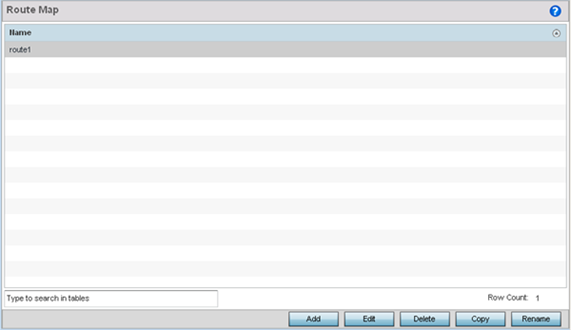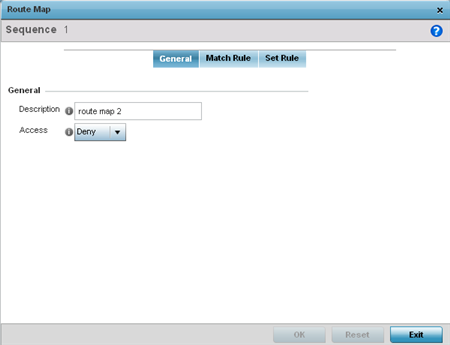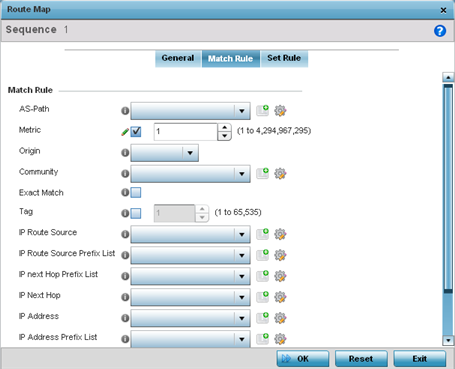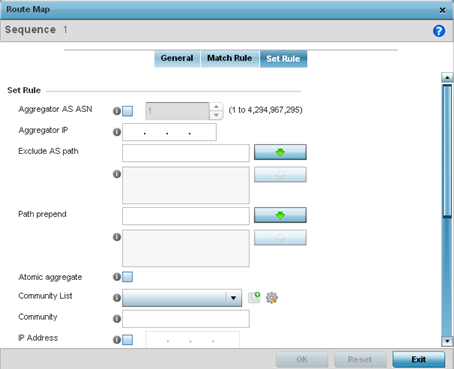Border Gateway Protocol (BGP)
About this task
Border Gateway Protocol (BGP) is an inter-ISP routing protocol for establishing routes between ISPs. ISPs use BGP to exchange routing and reachability information between Autonomous Systems (AS) on the Internet. BGP makes routing decisions based on paths, network policies and/or rules set by network administrators. The primary role of a BGP system is to exchange network reachability information with other BGP peers. This includes AS information the reachability information traverses. This information is sufficient to create a graph of AS connectivity from which routing decisions are created and rules enforced.
An Autonomous System (AS) is a set of routers under the same administration using Interior Gateway Protocol (IGP) and common metrics to define how to route packets. AS uses inter-AS routing to route packets to other ASs. For an external AS, an AS appears as a single coherent interior routing plan and presents a consistent picture of reachable destinations.
Routing information exchanged through BGP supports only destination based forwarding (it assumes that a router forwards packets based on the destination address carried in the IP header of the packet).
BGP uses TCP as its transport protocol. This eliminates the need to implement explicit update fragmentation, retransmission, acknowledgment, and sequencing. BGP listens on TCP port 179. The error notification mechanism used in BGP assumes TCP supports a graceful close (all outstanding data is delivered before the connection is closed).
To review existing BGP configurations or potentially create new ones:
Procedure
-
Select the Configuration > Network > BGP > Route Map.
In a BGP implementation, a route map is a method to control and modify routing information. The control and modification of routing information occurs using route redistribution rules.


-
Select Add to create a new route map,
Edit to modify the attributes of a selected route.
Existing route map configurations can be copied or renamed as needed.
The Route Map Rule screen lists existing rules and their access permissions.The Generaltab is displayed by default when adding or editing route maps.


-
Set the following General settings:
Description Provide a 64 character maximum description to help distinguish this route map from others with similar access permissions. Access Set the permit or deny access designation for the route map. The default setting is deny. -
Select the Match Rule tab.


-
Set the following Match Rule settings:
AS-Path An AS path is a list of Autonomous Systems (AS) a packet traverses to reach its destination. From the drop-down menu, select a pre-configured AS-Path list. Use the Create icon to create an AS-Path list or select an existing one and use the Edit icon. Metric Select this option to define the exterior metric (1 - 4,294,967,295) used for route map distribution. BGP uses a route table managed by the external defined. Setting a metric provides a dynamic way to load balance between routes of equal cost. Origin Use the drop-down menu to set the source of the BGP route. Options include: - egp - Matches if the origin of the route is from the exterior gateway protocol (eBGP). eBGP exchanges routing table information between hosts outside an autonomous system.
- igp - Matches if the origin of the route is from the interior gateway protocol (iBGP). iBGP exchanges routing table information between routers within an autonomous system.
- incomplete - Matches if the origin of the route is not identifiable.
Community Use the drop-down menu to set the autonomous system community. A new community can be defined by selecting the Create icon, or an existing autonomous system community can be modified by selecting the Edit icon. Options include: - internet - Advertises this route to the Internet. This is a global community.
- local-AS - Prevents the transmit of packets outside the local AS.
- no-advertise - Do not advertise this route to any peer, either internal or external.
- no-export - Do not advertise to BGP peers, keeping this route within an AS.
- aa:nn - The first part (aa) represents the AS number. The second part (nn) represents a 2-byte number.
Exact Match When matching the Community, use exact matching. The default setting is disabled. Tag The Tag is a way to preserve a route‘s AS path information for routers in iBGP. The default setting is disabled. IP Route Source The IP Route Source is a list of IP addresses used to filter routes based on the advertised IP address of the source. Use the drop-down menu to set the IP route source. A new route source can be defined by selecting the Create icon, or an existing one can be modified by selecting the Edit icon. IP Route Source Prefix List The IP Route Source Prefix List is a list of prefixes used to filter routes based on the prefix list used for the source. Use the drop-down menu to set the IP route source prefix list. A new list can be defined by selecting the Create icon, or an existing AS-Path can be modified by selecting the Edit icon. IP Next Hop Prefix List The IP Next Hop Prefix List is a list of prefixes for the route‘s next hop determining how the route is filtered. Use the drop-down menu to set the IP next hop prefix list. A new list can be defined by selecting the Create icon, or an existing IP next hop prefix list can be modified by selecting the Edit icon. IP Next Hop The IP Next Hop is a list of IP addresses used to filter routes based on the IP address of the next hop in the route. Use the drop-down menu to set an IP next hop. A new next hop can be defined by selecting the Create icon, or an existing IP next hop can be modified by selecting the Edit icon. IP Address The IP Address parameter is a list of IP addresses in the route used to filter the route. Use the drop-down menu to set the IP address. A new address can be defined by selecting the Create icon, or an existing IP address can be modified by selecting the Edit icon. IP Address Prefix List The IP Address Prefix List is a list of prefixes in the route used to filter the route. Use the drop-down menu to set the IP address prefix list. A new community can be defined by selecting the Create icon, or an existing IP address prefix list can be modified by selecting the Edit icon. - Use the drop-down menu to set the Math Rule Experimental Feature External Community setting. A new External Community setting can be defined by selecting the Create icon, or an existing External Community setting can be modified by selecting the Edit icon.
-
Select the Set Rule tab.


-
Define the following Set Rule parameters:
Aggregator AS ASN Select the Autonomous System Number (ASN) for the BGP aggregator. Aggregates minimize the size of routing tables. Aggregation combines the characteristics of multiple routes and advertises them as a single route. Select the ASN for this aggregator. Set a value from 1 - 4,294,967,295. This setting is disabled by default. Aggregator IP Provide the IP address of the route aggregator. BGP allows the aggregation of specific routes into one route using an aggregate IP address. Exclude AS Path Enter an AS, or a list of ASs, excluded from the AS path. Path Prepend Enter an AS, or a list of ASs, prepended to the AS path. Atomic Aggregate When a BGP enabled wireless controller or service platforms receives a set of overlapping routes from a peer, or if the set of routes selects a less specific route, then the local device must set this value when propagating the route to its neighbors. This setting is disabled by default. Community List The Community List is a list of communities added to the route. A BGP community is a group of routes sharing a common attribute. Community The Community is the community attribute set to this route. IP Address Set the IP address for this route. Enable (Next Hop Peer) Select this option to enable the identification of the next hop address for peer devices. This setting is disabled by default. Local Preference Select this option to enable the communication of preferred routes out of the AS between peers. This setting is disabled by default. Metric BGP uses a route table managed by the external metric defined. Setting a metric provides a dynamic way to load balance between routes of equal cost. Set a metric value for this route from 1 - 4,294,967,295. Origin Select the origin code for this BGP route. - egp - Sets the origin of the route to eBGP.
- igp - Sets the origin of the route to iBGP.
- incomplete - Sets the origin of the route as not identifiable. Set this if the route is from a source other than eBGP or iBGP.
Originator ID Set the IP address of the originator of this route map. Source ID Set the IP address of the source of this route map. Tag The Tag is a way to preserve a route‘s AS path information for routers in iBGP. Set a tag value from 1 - 65535. Weight Select this option to enable the assignment of a weighted priority to the aggregate route. The range is 1 - 4,294,967,295. - Click OK to save the changes, Reset to revert to the last saved configuration or Exit to close the screen.
